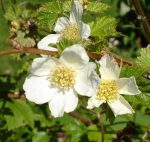
Also known as delicious raspberry, boulder raspberry and snowy bramble, this deciduous shrub or vine is native to Colorado, New Mexico, Wyoming, and the Oklahoma Panhandle. It is a member of the rose family, Rosaceae, that also includes lady’s mantle, cherry, and almond. Growing 5-10′ tall, plants have reddish arching canes with flaky, peeling bark and are thornless. The simple leaves are round to oval, 1.3-2″ long, and have 3-5 shallow lobes. In late spring white, rose-like flowers appear that are fragrant, inches 2–2.75″ across and have 5 petals. The fruit is a purple to wine-red berry that is considered dry, very seedy, and unappealing although attractive to birds. Plants are often used in xeriscapes and as hedges or screens. The genus name, Rubus, is the ancient Latin word meaning bramble. The specific epithet, deliciosus, is from the Latin word deliciae meaning delights and may refers to the showiness of the flowers.
Type: Flowering deciduous shrub
Outstanding Feature: Flowers
Bloom: White, single rose-like flower with 5 petals in late spring
Form: Upright
Growth Rate: Medium
Size: 5-10′ H x 5-6′ W
Light: Full sun to part shade
Soil: Average, dry to medium moist, well-drained
Hardiness: Zones 5-8
Care: Prune out 1/3 old canes in late winter to promote bloom.
Pests and Diseases: Raspberry mosaic virus, bacteriosis, crown gall, fire blight, mycosis, spur blight, leaf spot, anthracnose, yellow rust, powdery mildew, gray mold, cane blight, Phytophthora, Verticillium wilt, various beetles, caterpillar, weevil, gall midge, mites, aphids,
Propagation: Seed (requires stratification), cuttings, suckers
Outstanding Selections: ‘Tridel’ (hybrid with larger flowers)
Photo Credit: Ulf-Eliasson-Wikipedia